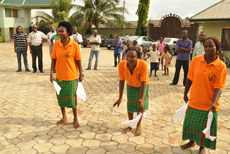Brief History
 Nigeria, giant of Africa, has forged ahead as a united entity despite having about 250 ethnic groups. Having got its independence on October, 1, 1960, today, it has 36 states and a Federal capital territory, Abuja. Lagos, the former capital, remains the country’s commercial nerve-centre. Port Harcourt city, and indeed, most of the south-south states, serves as the oil and gas hub of the country.
Nigeria, giant of Africa, has forged ahead as a united entity despite having about 250 ethnic groups. Having got its independence on October, 1, 1960, today, it has 36 states and a Federal capital territory, Abuja. Lagos, the former capital, remains the country’s commercial nerve-centre. Port Harcourt city, and indeed, most of the south-south states, serves as the oil and gas hub of the country.
Despite political and religious differences among its people, Nigeria remains a land of opportunities. Its natural resources include petroleum, natural gas, tin, columbite, iron ore, coal, limestone, lead, zinc, hydropower and arable land. However oil and gas account for more than 90% of the country’s foreign exchange earnings. Agriculture, the petrochemicals, power, rail transportation, refineries, infrastructures, manufacturing, etc. have huge investment opportunities for the country.
A warm people, Nigerians – 156 million by 2006 census - occupy a total land area of 910,768 square kilometers. The main ethnic groups are Hausa, Ibo and Yoruba but the official language is English. Nigerians enjoy good tropical climate and rainfall. Major religions are Christianity, Islam and indigenous beliefs.
Nigeria has huge market, and is a heaven for investments.
Natural Beauty
 For those who buy into the stereotype that Africa is by and large dry, arid desert land, Nigeria will come as a shock, a pleasant one. To begin with, there are two rivers running through Nigeria: the long-winding Niger, the third largest river in Africa and the easy negotiable Benue River. That pretty much takes care of dry arid conditions. Nigeria for the most part is lush, green and untouched with a rich and varied landscape.
For those who buy into the stereotype that Africa is by and large dry, arid desert land, Nigeria will come as a shock, a pleasant one. To begin with, there are two rivers running through Nigeria: the long-winding Niger, the third largest river in Africa and the easy negotiable Benue River. That pretty much takes care of dry arid conditions. Nigeria for the most part is lush, green and untouched with a rich and varied landscape.
The far south is covered in rainforest and enjoys tropical rainforest climate, with plenty of rainfall and thick-forested areas which are rich in all types of flora, fauna and animal life. In the southeast lies the Obudu plateau and in the highlands lies the Mambilla Plateau. Both these places experiences relatively colder weather. This region, with its hills and valleys is panoramic.
Between the southeast and southwest, in the region that runs along the coast, we find coastal plains. This region has maritime weather and some truly spectacular beaches that have not been touched by commercialization and retain their clean and pure beauty.

